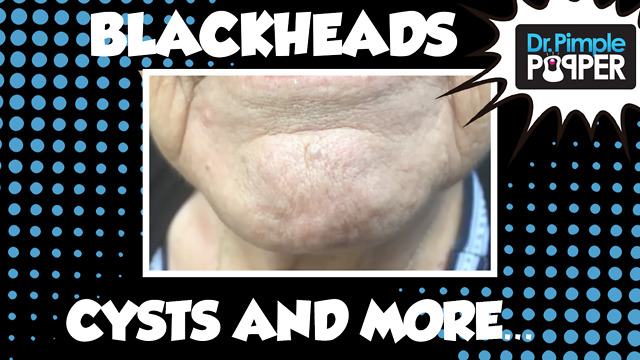Premium Only Content

Blackheads, Milia, Inflamed Cyst & MORE!
A milium (single for milia) is a small superficial cyst formed in the top layer of the skin called the epidermis. They appear as tiny, pearly-white bumps just under the surface of the skin. They contain keratin (skin protein) and are harmless. They are often seen on the face, in particular on the delicate skin around the eyes. They can be prevented or minimized with exfoliating like chemical peels, microdermabrasion or topical retinoids. However, they are sometimes difficult to remove without a physician’s help, since they cannot simply be squeezed out. Often, the surface of the skin has to be pierced first with a lancet, a sharp pointed blade, or a needle, in order to successfully remove the milium. Often a comedone extractor is used to express the milium.
I put “infected” in quotes, because technically this is not an infection: When an epidermoid cyst ruptures, it creates a vigorous foreign body inflammatory response - this skin becomes warm, tender, painful, and swells, simulating an abscess. Incision and Drainage (I & D), will confirm the diagnosis of inflamed cyst, when the cheesy, sometimes odiferous material is evacuated, and this process often leads to rapid resolution of symptoms. These episodes are often misdiagnosed as “infection” of the cyst, but cultures are usually negative and antibiotic treatments is not required. Intralesional steroids can hasten the resolution of symptoms as well.
A blackhead is also called an open comedo (single for comedone), and it is a clogged pore in the skin that is open to the air. Keratin (skin protein) and sebum (oil) combine to block the pore. They are often found on the face and trunk. but they can be found anywhere on the body. Blackheads are not clogged with dirt, but it is the exposure to air that causes oxidation turning the internal contents black’. They can be extracted using a comedone extractor. I usually use an 11 blade (a blade that comes to a sharp point) and a Shaumberg type comedone extractor.
An epidermoid cyst (Epidermal Inclusion cyst, Infundibular cyst), is a benign growth commonly found in the skin and typically appears on the face, neck or trunk, but can occur anywhere on the body. Another name used is “sebacous cyst” but this is actually an antiquated misnomer, and is not a term used by dermatologists. They are also the most common type of cutaneous cysts. Epidermoid cysts result from the reproduction of epidermal cells within a confined space of the dermis. The pasty contents are mostly composed of macerated keratin (wet skin cells), which creates this “cheesy” consistency, and there can be a pungent odor. An epidermoid cyst may have no symptoms and are typically harmless. Usually people seek removal but they don’t like the appearance of these bumps, or the cyst has ruptured or been inflamed or “infected” in the past. Rupture is associated with sudden redness, pan, swelling, and local heat, and can lead to abscess formation. Also, a history of inflammation, often increases scar tissue in the area, makes the cyst more firmly adherent to surrounding skin, and makes it more difficult to remove. Surgical excision is curative, but the complete cyst removal including the entire cyst sac and contents need to be removed to ensure that the cyst won’t reoccur.
Subscribe to my Dermatology educational channel, Dr Pimple Popper University! Link is here:
https://www.youtube.com/channel/UCvaD01Jb_ruxsAcVqVmTHzQ
To buy your own Official Dr. Pimple Popper Comedone Extractor, click here:
https://www.drpimplepopper.com/shop
For more content, exclusive content, and of course to get more Dr. Pimple Popper schwag, visit us at www.drpimplepopper.com!
Instagram:
@DrPimplePopper for 24/7 pops
@DrSandraLee for my work, my life, my pops
Facebook: facebook.com/DrSandraLeeDermatology
Twitter: @SandraLeeMD
Snapchat: drpimplepopper
Periscope: Dr. Sandra Lee
You can watch my TV appearances here:
https://www.youtube.com/channel/UCOixDRVQAsKe4STSuWU8U0Q
This video may contain dermatologic surgical and/or procedural content. The content seen in this video is provided only for medical education purposes and is not intended to be a substitute for professional medical advice, diagnosis, or treatment.
-
 3:36
3:36
Health information and tips for people
4 years ago $0.04 earnedEasy Way to Remove Blackheads Naturally
261 -
 0:28
0:28
thedreamstarter
4 years agoMore, more, more (MikesInnerCircle)
57 -
 0:30
0:30
Jalaxy's Galaxies
4 years agoMore Foxes
382 -
 10:59
10:59
Appalachian Farmstead
4 years agoMore Snow!!!
16 -
 2:36
2:36
KGUN
4 years agoMore 70s!
9 -
 0:11
0:11
AlpineTX
4 years agoMore Elk
58 -
 8:00
8:00
AFV
4 years agoMore Pranks
2.36K3 -
 0:41
0:41
ShawnPatanjo
4 years agoMore backyard!
1001 -
 1:11
1:11
katieparsons
4 years ago $0.04 earnedMore Toffee?
1131 -
 2:17
2:17
WXYZ
4 years agoMore clouds
31